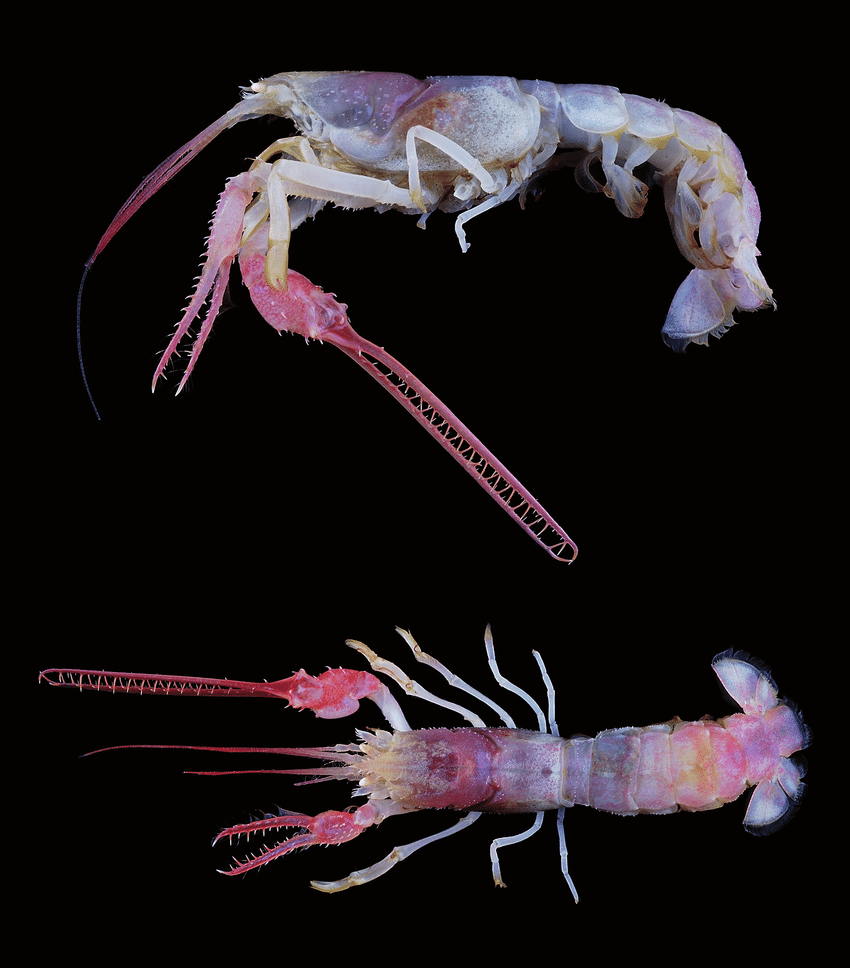What monsters lurk below the sea surface?
None really!
But there are some weirdly wonderful creatures that, despite their names (and sometimes their looks), are not really that scary.
This Halloween, let’s take a dive into the depths for a quick visit of seven not-so-spooky sea creatures.
Terrible claw lobster (Dinochelus ausubeli). Credit Ahyong et al (2010).
1. Terrible claw lobster
One of these claws is very much not like the other!
Not much is known about these deep-sea lobsters, or what they do with these “terrible” claws. Although other crustaceans sport two different-sized claws (hello fiddler crabs!), the difference between the sizes of this lobster’s claws is very impressive.
2. Common fangtooth
Those may look like some massive teeth, but everything is relative. Common fangtooths reach just 18 centimetres in length, so to us, they are pretty small. But if you are a smaller fish, crustacean, or cephalopod…
The fangs only appear once the fish reach adulthood. Before then, the fangtooths sport much smaller teeth.
Fangtooth fish (Anoplogaster cornuta). Credit Personnel of NOAA Ship PISCES/Flickr (CC BY 2.0)
Tongue-eating louse (Ceratothoa italica) in a bogue (Boops boops). Credit: Lutz Popper/Flickr (CC BY-NC-SA 2.0)
3. Tongue-eating louse
If I were a fish and I had to pick between a male tongue-eating louse or a female, I’d probably go male.
Why?
Both fish get into the fish through the gills, but males stay on the gills. It’s only the female that goes for the tongue. The louse cuts off the blood supply to the tongue, causing it to drop off. The louse then takes the place of the fish’s tongue.
4. Bloodybelly comb jelly
Despite the name, the belly of this jelly is not bloody. Rather, the colour is caused by light refracting and diffracting off the tiny cilia that cover the jelly and propel it through the water.
When the jellyfish is in the deep sea, there is no light, so the bellies actually appear black! Scientists think this helps hide the bodies any bioluminescent critters that met an unfortunate end in the jelly’s belly.
A ghost anemone. Credit: VIMS/Flickr (CC BY-NC-ND 2.0)
5. Ghost anemone
Originally native to the east coast of North America, these beautiful anemones are now found across the world.
Their spread isn’t entirely natural. Instead, they’ve hitched a ride attached to many a ship as it crosses the ocean.
6. Masked pufferfish
If you love seafood, you probably want to make sure you stay clear of this fish.
Like other pufferfish, this masked beauty contains tetrodotoxin, a toxin that is produced by bacteria consumed by the fish. Consuming the toxin could lead to muscle paralysis, respiratory failure, cardiac failure, and death.
Masked pufferfish (Arothron diadematus). Credit Derek Keat/Flickr (CC BY 2.0)
Hagfish showing its toothplates. Credit: Zintzen et al (2011)
7. Hagfish
There are famous for two things. One is their slime. The other is that they are the only known living animal to have a skull but no spine. They are also jawless.
Jawless? But what are all those teeth on?
Toothplates.
Toothplates are strong, flat surfaces lined with razor-sharp teeth. When the toothplates are sticking out of the hagfishes’ mouth, they can rasp and tear at the flesh of their prey and carcasses they find with incredible efficiency.





